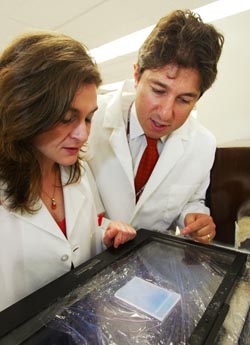Researchers may have unlocked the mechanisms that silence the estrogen receptor gene alpha during breast cancer
The mechanisms that silence the estrogen receptor gene alpha
(ER - α) in certain breast cancer cell lines may be closer to being unlocked.
 Photo by Joseph V. Labolito/Temple University Marcella Macaluso, research assistant professor, and Antonio Giordano, M.D., Ph.D., director of Temple University's Sbarro Institute for Cancer Research and Molecular Medicine believe they may have discovered the mechanisms that silences the estrogen receptor gene alpha (ER-α) in certain breast cancer cell lines.
|
The mechanisms that silence the estrogen receptor gene alpha (ER-α) in certain breast cancer cell lines may be closer to being unlocked, according to a study by researchers at Temple University’s Sbarro Institute for Cancer Research and Molecular Medicine. The researchers reported their findings, “Epigenetic Modulation of Estrogen Receptor-α by pRb Family Proteins: A Novel Mechanism in Breast Cancer,” in the Aug. 15 issue of the journal Cancer Research (http://cancerres.aacrjournals.org/ In a previous study, the researchers found that in estrogen receptor-positive and estrogen receptor-negative mammary cell lines of women who have been affected with breast cancer, the tumor-suppressing gene pRb2/p130 binds to a specific region of the estrogen receptor gene alpha and forms molecular complexes recruiting and/or interacting with several proteins. They discovered that in estrogen receptor-negative cells — which are able to silence the expression of the estrogen receptor — pRb2/p130 forms a specific molecular complex recruiting a different sequence of proteins than in the estrogen receptor–positive cells. |
|
In the current study, lead by Antonio Giordano, M.D., Ph.D., director of the Sbarro Institute, the researchers showed that the presence of specific pRb2/p130 multimolecular complexes bound to the estrogen receptor gene strongly correlates with the methylation (chemical modification) of the gene. “Our hypothesis is that the sequence of epigenetic events for establishing and maintaining the silenced state of the estrogen receptor gene alpha during the breast cancer progression is mediated by pRb2/p130 in association with specific proteins that modified the DNA structure through specific mechanisms,” said Giordano, who discovered the Rb2 gene while working at Temple’s Fels Cancer Institute in the early 1990s. “In other words, the presence of a specific pRb2/p130 multimolecular complex may dictate a local change of the DNA structure of the estrogen receptor alpha gene and influence its susceptibility to chemical modification (DNA methylation), as well as to different epigenetic alterations leading to estrogen receptor alpha silencing,” added Marcella Macaluso, research assistant professor at the Sbarro Institute and the study’s lead author. Giordano says this study provides a basis for understanding how the complex pattern of estrogen receptor gene alpha methylation and transcriptional silencing is generated, as well as for understanding the relationship between this pattern and its function during breast cancer progression. By understanding this mechanism of how pRb2/p130 recruits molecules, he says, researchers will be able to design therapies and drugs that are very precise in the target they recognize. “One gene on its own doesn’t mean anything,” he explains. “It’s the dialogue among the genes that are writing the sentences, and this finding really writes a very important sentence in the book that we are authoring on uncovering the understanding of how a normal cell functions and why some therapies work or some therapies don’t work. It also clearly shows that cancer is not the event of one gene, but an army of genes and it looks like pRb2/p130 is one of the generals.” Giordano and Macaluso were joined in this study by research fellow Micaela Montanari and doctoral students Paul Bart Noto and Valter Gregorio from the Sbarro Institute, and Professor Christian Bronner from the Centre National de la Recherche Scientifique/Université Louis Pasteur in France. The study was coordinated by Giordano and carried out at Temple’s Sbarro Institute and the Department of Human Pathology and Oncology at the University of Siena in Italy. It was funded by the National Institutes of Health, the U.S. Army Medical Research and Material Command and the Sbarro Health Research Organization. ***** NOTE: Copies of this study are available to working journalists only and may be obtained by contacting Preston M. Moretz in Temple University’s Office of Communications, 215/204-7476 or pmoretz@temple.edu.
|
|